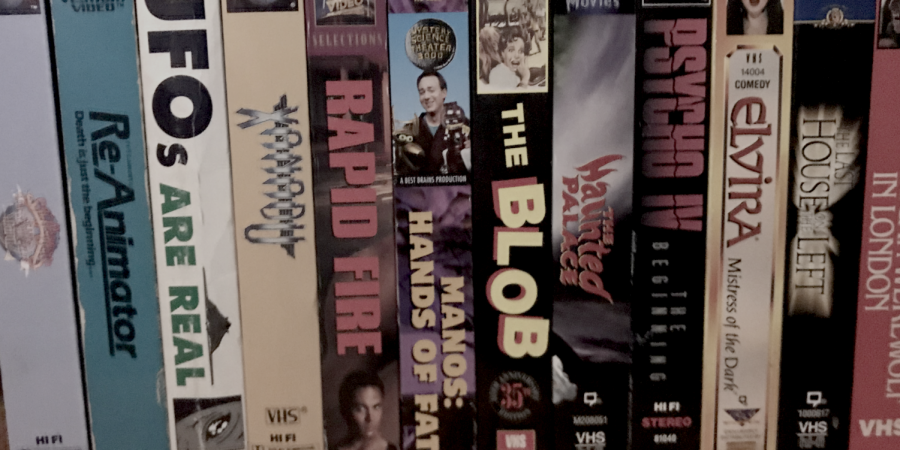A cut below the rest: The history and appeal of B-movies
January 19, 2018
With online streaming sites, Blu-Ray, and TV channels dedicated to film, it has become less of a necessity to see our favorite movies in the theater. It’s hard to believe that there was a time when you couldn’t simply look up a movie on Netflix, or visit your local library to pick up a copy. Back when theaters were always filmed to the brim with people, they almost always needed to have something playing. Obviously, all of those movies couldn’t have an extravagant budget. Instead, B-Movies shone through the fog.
Originating in the “golden” era of Hollywood, B-Movies were the films that were low budget, not mainstream, and were also often categorized as genre films. The term “genre” covers a wide range of art, but is most commonly in respect to horror, sci-fi, western, and comedy movies.
The birth of the B-Movie came from the many series’ of western that were produced in the 30s. They commonly came with one big name star, and followed roughly the same plot. They were very repetitive, but companies enjoyed the cash intake. One of the firsts was The Big Trail, starring John Wayne. He would go on to star in many of the early western B-movies.
As the 40s and 50s rolled around and the amount of money required to shoot a movie increased, ideas of time travel, aliens, and unusual species took over the B-movie scene. RKO Pictures stepped up to the forefront in terms of the subgenre, bringing producer Val Lewton along with them. Films like Cat People, The Body Snatcher, and I Walked With A Zombie became very popular as matinées, and components in the common “double features” at drive-ins. Since these films were cheap, fun, and targeted at the growing rebellious youth, they became underground hits. The effects, acting, and sets reflected the low budget, and by today’s standards they haven’t aged well.
The 60s and 70s were really when the term B-Movie flourished, as well as being deemed exploitation films. While directors like Alfred Hitchcock kept a tight grasp on their spots in mainstream media, other’s were proud to hold the title of a B-Movie director. William Castle bumped up the campiness of the 50s sci-fi films and added audience interaction, and George A. Romero pushed boundaries with what was appropriate to display on screen.
“If you don’t have any money, you better be prepared. You know, how’s this is going to work, how are we going to pull this stuff off with a micro budget, because that’s what we had on [Halloween and Assault on Precinct 13]. They were planned out to the shot,” John Carpenter, director, said.
By the 1980s, the sub-genre was littered with low-budget horror movies and even the mainstream films took ideas from those below them. Wes Craven’s A Nightmare On Elm Street had all the gore, and one-liners of a successful B-Movie but had a budget of almost two million dollars. The movie sparked an expansive series of sequels, each one increasing in budget and revenue as they went on. But, those with a lower budget always seemed to be hitting their target audience, and scaring the pants off the teens packed into the small theaters.
“The scariest movies are created outside the studio system on non-existent budgets by people who will stop at nothing to terrorize an audience,” Stuart Gordon, director, said.
But why have these films stuck around? Why do people still get a kick out of the campyness of 50s horror, or the French mystery giallos, or the Japanese monster movies? It’s because we like the nostalgia, the over the top acting, and the terrible effects. These films are goofy, and normally pretty repetitive, but we just can’t get enough of them.
People have loved B-Movies so much, many of the mainstream films of our era continued to reflect those ideas. Any superhero movie plot would have sounded crazy in the early 60s when the B-Movie scene was dominated with Invasion of the Neptune Men and Attack From Space. The major movie companies put millions of dollars into these crazy ideas, when they use to only put a few hundred thousand, because now it’s hip to be a little crazy, and a little over the top.
We live in a time where sequels and remakes are coming out every other week. Blade Runner 2049, It, and the recent Star Wars sequels have dominated the box office because of their large following and they show how the ideas of B-Movies have progressed into our modern day. Of course, there are plenty of true under-grade movies being made. Sharknado, with its four sequels, is the most successful film to bank on the idea of “being bad,” and the trend seems to still be on the rise.



